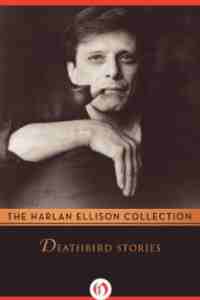Deathbird Stories by Harlan Ellision
 Friday, August 21, 2015 at 8:02AM
Friday, August 21, 2015 at 8:02AM 
First published in 1975; published digitally and in trade paperback by Open Road Media on June 3, 2014
I read Deathbird Stories in paperback in the late 1970s. At that time, I did not think it was one of Harlan Ellison's stronger collections. Rereading it after its recent re-release in digital form, I revised my opinion. Some of the stories are powerful -- you expect that from Ellison -- but others are subtle. I think I missed the subtlety the first time. Maybe I ignored Ellison's advice and read them all at once. This time I read one each day and that may have enhanced my appreciation of the collection as a whole.
The stories generally revolve around a central theme. The god(s) once worshiped have been replaced by more malevolent forces. The new gods are rage, greed, sadism, narcissism, alienation, selfishness, and similar characteristics that good people try not to nurture. The new gods are slot machines, guns, drugs, advertising, and anything that can be conspicuously consumed. Ellison's point seems to be that modern life has made it difficult to distinguish the angels from the demons.
Each story is preceded by an introductory sentence or two. "Paingod" is preceded by "If God is good, why does He send us pain and misery?" The answer that this excellent story delivers seems to be: because we deserve it. Maybe we even need it.
In the standout story "Ernest and the Machine God," a manipulative woman learns that God might be a lunatic but He protects the innocent. Also riffing on the notion of God's madness is "Deathbird," which suggests that the serpent might be more trustworthy than God or that man, in the end, might be more powerful than God. My favorite portion of "Deathbird" is Ellison's moving tribute to the dog that inspired "A Boy and His Dog."
The most powerful story was inspired by the infamous murder of Kitty Genovese, a murder that several New Yorkers watched without trying to intervene. "The Whimper of Whipped Dogs" tells of a woman who encounters a city grown malicious after she watches a woman being murdered and does nothing to help. Like the movie Taxi Driver, the story is about the changes that the "insane asylum of steel and stone" we call a city forces upon its inhabitants.
In another powerful story, a man who desperately wants to die searches for his lost soul and is surprised by what he finds. A touching story about wasted lives, "Adrift Just Off the Islets of Langerhans" might be my favorite in the collection.
One of the best of the subtle stories is "Corpse," a meditation on abandoned vehicles and down-trending gods. Another quietly impressive story, "On the Downhill Side," introduces a man and a woman (and a unicorn) who spend a night in conversation, their one chance to end their ghostly punishment for mistakes of love.
Other stories I admired are:
"Along the Scenic Route" - Drivers vent their road rage via government-sanctioned duels.
"O Ye of Little Faith" - A man who denies love, who self-indulgently isolates himself, who believes in nothing, discovers the truth about himself when no one believes in him.
"The Basilisk" - A captured soldier, in an unnamed war that is clearly Vietnam with the addition of biblical beasts, betrays his country under torture and is, in turn, betrayed by his family, friends, and the town in which he grew up.
"Pretty Maggie Moneyeyes" - A loser puts his last silver dollar in a slot machine and wins -- and wins again and again -- but he isn't the first person to be sucked into the machine.
"The Place With No Name" - A pimp, fleeing from the scene of a murder and chased by the police, is offered an escape -- and a chance to meet Prometheus, and maybe even to wear a crown of thorns.
"Rock God" - A shady developer falls prey to an awakening rock god (the Stonehenge variety, not Eddie Van Halen).
Rounding out the collection are stories I enjoyed less, but none of them are bad:
"Neon" - A man whose life is saved is given odd surgical enhancements (a neon coil, a metal finger, and a glowing red eye) finds himself haunted by messages of love.
"Shattered Like a Glass Goblin" - In a story that seems more dated than the others, residents of a drug house turn into monsters.
"Delusion for a Dragon Slayer" - Given the chance to prove his fitness for entrance into Heaven, a man is defeated by his own vanity.
"The Face of Helene Bournouw" - A beautiful woman is actually a succubus, programmed by demons.
"Bleeding Stones" - Gargoyles on a St. Patrick's Cathedral come to life and ravish nuns.
"At the Mouse Circus" - Dreams don't always work out in the way you expect.
None of Ellison's very best stories are found in this volume, but even second-tier Ellison is better than the first-tier work of most writers.
RECOMMENDED
Reader Comments